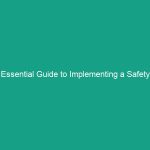Good Morning Team
Today, we’re going to talk about a crucial topic that affects all of us who work with cranes: Crane Proximity to Power Lines. Understanding how to maintain safe distances from power lines can mean the difference between a safe work Environment and a hazardous situation. This is not just about compliance; it’s about ensuring everyone goes home safe at the end of the day.
Understanding Crane Proximity to Power Lines
Crane proximity to power lines refers to the safe distances that must be maintained between cranes and overhead power lines to avoid Electrical Hazards. When cranes operate too close to power lines, they risk coming into contact with high-voltage electricity, which can lead to serious injuries or fatalities.
Many employees may think that as long as they’re not touching the power lines, they’re safe. This is a misconception. Electrical arcs can jump significant distances, so it’s vital to maintain a safe distance, even when the crane doesn’t make direct contact with the wires.
Key Hazards, Risks, and Safety Considerations
Working near power lines presents several Hazards:
- Electrical Shock: Contact with power lines can result in severe electrical shocks, leading to serious injuries or death.
- Arc Flash: High-voltage electricity can create an arc flash, which is an explosive release of energy caused by an electrical fault. This can cause Burns or other injuries.
- Equipment Damage: Cranes coming into contact with power lines can lead to expensive equipment damage and project delays.
Ignoring Safety protocols can have real-world consequences. For instance, there have been multiple incidents where cranes have caused power outages or have led to severe injuries. These incidents highlight the importance of understanding the risks and adhering to Safety Guidelines.
Best Practices, Procedures, & Actionable Advice
To ensure safety around power lines, follow these Best Practices:
- Know the Safe Distances: Always be aware of the minimum safe distances required from power lines. For example, OSHA recommends maintaining at least a 10-foot distance from power lines rated up to 50kV.
- Use Spotters: Designate a spotter to keep an eye on crane operations near power lines. The spotter can help ensure that the equipment maintains a safe distance.
- Plan Your Operations: Before starting work, map out where power lines are located and plan your crane operations accordingly.
- Utilize Insulating Barriers: If you must work near power lines, consider using insulating barriers to help mitigate risks.
- Regular Training: Ensure all operators and crew members are trained on Safe Practices and understand the risks associated with working near power lines.
Let’s consider a real-world example. A construction site once faced a serious incident when a crane operator was unaware of the proximity of power lines. Fortunately, a vigilant spotter noticed the crane getting too close and alerted the operator just in time. This incident underscores the importance of communication and adherence to safety practices.
Regulations, Standards, and Compliance
Adhering to safety Regulations is not just good practice; it’s a legal requirement. osha has established several guidelines regarding working near power lines. Here are a few key points:
- OSHA Standard 1926.1408 outlines the requirements for maintaining safe distances from power lines.
- Compliance with these Standards helps protect not only the employees but also the company from legal repercussions and financial losses.
Understanding and following these regulations is critical for maintaining a safe work environment.
Employee Engagement & Discussion
Let’s open the floor for discussion. Have you encountered safety challenges related to working near power lines? What measures do you think can be implemented to enhance our safety protocols? Your input is valuable, and together we can improve our safety practices.
Conclusion & Key Takeaways
In summary, maintaining safe distances from power lines is essential for everyone’s safety on the job site. Remember the key points we discussed:
- Always know the safe distances required.
- Use spotters and plan operations carefully.
- Follow OSHA regulations to ensure compliance and safety.
Let’s make a commitment today to prioritize safety. By doing so, we’re not just following rules; we’re protecting ourselves and our coworkers. Thank you all for your attention and dedication to making our workplace a safe environment.


